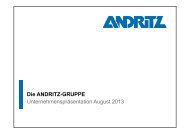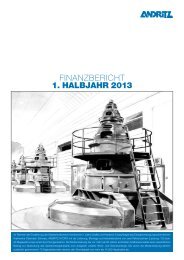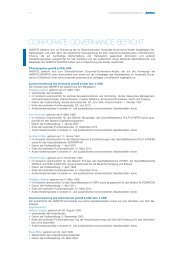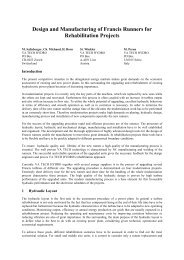ANDRITZ annual report 2012 - ANDRITZ Vertical volute pumps
ANDRITZ annual report 2012 - ANDRITZ Vertical volute pumps
ANDRITZ annual report 2012 - ANDRITZ Vertical volute pumps
You also want an ePaper? Increase the reach of your titles
YUMPU automatically turns print PDFs into web optimized ePapers that Google loves.
50<br />
as tough<br />
Business<br />
as steel<br />
Christoph Lindner is Managing Director of<br />
Consultic. The company is a member<br />
of PSYMA Group AG, a holding<br />
company comprising 16 international<br />
firms researching various<br />
industries. He is an expert on<br />
the global steel market and<br />
has also prepared studies for<br />
<strong>ANDRITZ</strong>. In his analysis,<br />
Christoph Lindner explains the<br />
underlying reasons for the<br />
current turbulence<br />
on the steel market<br />
and ventures a<br />
glance into the<br />
future.<br />
Driven by the extremely high demand<br />
for steel in China, global steel production<br />
increased by more than<br />
50% between 2000 and 2008. It<br />
then fell by 8% in 2009 compared<br />
to 2008 as a result of the economic<br />
and financial crises. Nevertheless,<br />
China recorded a sharp rise in steel production (+14%)<br />
even in this economically difficult year.<br />
The steel industry has not really recovered since then.<br />
In <strong>2012</strong>, global steel production did rise again, but<br />
the price for most steel grades remained low. Consequently,<br />
most international steel producers<br />
again faced a major financial struggle, and<br />
many recorded losses.<br />
There is a variety of reasons why the strong increases<br />
of the previous years came to an end and why current<br />
forecasts are pessimistic. For example, falling demand<br />
for steel in the European Union in the first half of <strong>2012</strong><br />
(down by 9% on the same period in the previous year)<br />
can partly be explained by the debt crisis. Important<br />
customers, such as car manufacturers or<br />
those from the construction sector, are struggling<br />
in the face of the uncertain state of the<br />
economy and are therefore holding back on<br />
placing orders. The demand for long steel products,<br />
which are mainly used in construction, as well as the<br />
demand for flat steel, which is important in car and<br />
machine construction, were still under pressure until<br />
the end of <strong>2012</strong>. Alongside the accompanying low level<br />
of capacity utilization, steelmakers are still struggling<br />
with fluctuating prices for raw materials and in some<br />
cases harsh environmental and emissions standards.<br />
The times when the steel industry was able<br />
to rely on high growth powered by the driving<br />
force that was China are now over. In <strong>2012</strong>, it<br />
became apparent just how dependent the steel industry<br />
is on China. Economic growth in China has now<br />
fallen to its lowest level since the global financial crisis<br />
of 2008/2009, and this is being felt worldwide. However,<br />
despite weakening global and local demand,<br />
China, as the world’s most important steel producer, is<br />
not cutting back on production. This has resulted in a<br />
surplus production of 200 million tons of steel a year.<br />
This overcapacity is leading to very low profit margins<br />
for Chinese steelworks, as well as a fierce price competition.<br />
The possibility of reducing overcapacities by<br />
closing plants is not being considered, or at least only<br />
to a marginal extent, out of fear of unrest among workers<br />
and the wider population. Instead, the building of<br />
new steelworks is being planned. Resolving the problem<br />
is therefore being postponed to the near future.<br />
China is seeking to export its surplus steel at low prices,<br />
mostly to its neighbors.<br />
This picture of the steel market is also, to some extent,<br />
applicable to the high-grade steel market, which only<br />
accounts for around 2% of the overall market. Extremely<br />
high growth rates are a thing of the past. Consider-
















